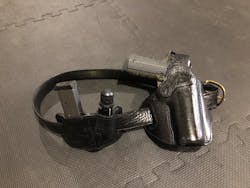Training for CCW / Immediate Responders
Across our nation today there are at least 38 states wherein the laws do not restrict the citizens from carrying a firearm – either open or concealed – on their person day in and day out as they go about their business. That number of states is probably even higher than 38 but there are a few states left that are still “May Issue” instead of “Shall Issue” and there are some states where there is no permitting process at all. Those Constitutional Carry states recognize their citizens’ right to be armed without restraint or restriction. This reality means that, in the event of an active shooter / active attacker, there are potentially plenty of armed citizens in the vicinity or on the scene who can or might engage the attacker(s). This presents a challenge as discussed in other articles: it means more people not in uniform with guns presented and possibly being fired. How are the responding law enforcement professionals supposed to know who is a good guy and who is a bad guy? While there are a plethora of commercial identification solutions on the market ranging from badges to reflective sashes, reality is that none of them are that great in the heat of the moment. In a highly dynamic situation, often with poor visibility, anything short of a full uniform might not be easily recognized and even in full uniform, the sad truth is that officers have been shot by fellow officers by accident.
The best answer to this challenge is training, training and then some more training. While the large majority of law enforcement officers fully support the 2nd Amendment and every lawful adult citizen’s right to be armed, there is an equal fear: that confusion will occur at the most critical of times and shots will be fired that never should be. This is the same challenge that potentially occurs anytime one law enforcement officer pulls another over for a traffic violation or any armed citizen for that matter. The situation doesn’t call for any level of force if everyone is law abiding, but the unknown or unexpected presence of firearms can raise nervous tension and cause misunderstandings.
The easiest way to avoid the situation is to remain cognizant of the potential and do all you can to avoid it. This is works on both sides: The law enforcement side looking at citizens and the citizen side looking at law enforcement. The challenge is that law enforcement professionals are required as part of their employment to be trained and update that training annually (at a minimum). That same requirement doesn’t exist for citizens, so it behooves them to set that standard for themselves and discipline themselves to partake of that training.
What needs to be trained? From the law enforcement perspective, slowing down as much as is possible without further risking life or limb (of the officer or anyone else) is what’s needed. Observe the situation you’re rushing into and see if you can decipher who is shooting whom – or aiming at – and why. LOUD and clear verbal commands should always accompany presentation of lethal force.
From the citizen’s side, LISTENING for those loud verbal commands and complying with them as quickly as is safely possible is what’s needed. It’s even better if you can have that weapon holstered or on the ground in a safe condition before the responding law enforcement officers get a chance to challenge you.
At a bare minimum, those who carry a firearm day to day, law enforcement or otherwise, should be well trained and practice their skills. That list of training and skills should include:
Legal briefs, updates and reviews. The law changes constantly and court precedent regularly evolve how laws are interpreted. It is beholden upon the armed citizen to stay as legally informed as the law enforcement professional is.
Basic and advanced skills. Safely carrying, storing and maintaining a weapon is a small part of the skill set necessary. Basic marksmanship – being able to put your shots where you want them – is required. Advanced marksmanship / weapon manipulation should be considered mandatory by everyone who carries a weapon. It should be a “self requirement.” What do you do if the weapon malfunctions? Do you know anything about ammunition management? Do you know how to safely manipulate the weapon if you get injured and only have one working limb? What if it’s your support hand?
Communication. Communication is perhaps the single most important skill needed by both law enforcement and the armed citizen. When a lawfully armed citizen intervenes in a criminal situation that includes presenting and potentially using lethal force, they had best know how to respond to the law enforcement officers who will inevitably respond to the scene. The armed citizen should be familiar with what the expectations of the responding officers will be. What will the commands be? What postures will the citizen be ordered into?
Don’t mistake being a lawfully armed citizen with being automatically recognized as such by the responding officers. It may feel insulting or inconvenient, most especially if you’ve just done something that most folks view as heroic, but you will be required to obey the commands of the responding officers without hesitation, without argument and without doing anything they don’t order you to do. Minor mistakes and misunderstandings can result in big responses, so it’s best to practice that compliance. It’s not meant as insult. It’s required so that the officers can perform their job and keep everyone as safe as possible along the way.

